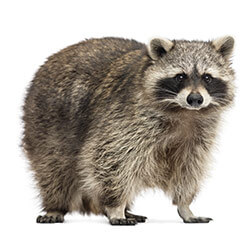Identification
- Colour Grey to reddish-brown
- Size Up to 95 cm
- Description Raccoons have rings around their bushy tails and distinctive mask-like markings on their faces. They have five digits on all four of their feet, and their front paws work similarly to human hands.

How to identify Raccoons
Well adapted to life in both urban and suburban communities, raccoons can be found throughout Southern Canada. The pests are omnivorous and easily recognized for their bushy tails and distinctive mask-like markings on their faces. When they take up residence under porches, within abandoned buildings, and in barns, raccoons cause property damage and leave humans, pets, and livestock at an increased risk of disease contraction.
Stocky animals, raccoons can weigh between 6 and 22 kilograms and grow up to 95 cm in length. Males are generally larger than females. Typical colouration ranges from grey to reddish-brown, but raccoons always have telling markings around their eyes and rings around their tails. Raccoons have five digits on all four of their feet, and their front paws work similarly to human hands.
Raccoon Sounds
Raccoons use over 200 sounds for communication and are capable of emitting a wide range of noises depending on various factors. The pests vocalize excitement in the form of screeching, chittering, and chirping, while warnings are issued using grunts, growls, and snarls. Some of the more unusual raccoon sounds include whistling and clicking of the teeth. At night, these pests may emit screams capable of waking up homeowners and frightening children.
Infestations within attics and homes are often identified by nighttime clawing and gnawing sounds within the walls. Shrieks, screams, and growls are signature raccoon noises not made by similar pests such as rats, mice, and squirrels. Those with families of raccoons nesting their homes may hear low, drawn out purring noises from mothers or high-pitched yelps and chirps from babies. Many of the identified raccoon sounds are used exclusively between mothers and their cubs.
Signs of Infestation
When raccoon infestations are present in buildings, the pests tend to make a lot of noise. House residents may hear scratching, rustling, and squeaking, especially during evening hours. Raccoons also set up latrines near their dens, which is where they deposit their urine and excrement. As such, foul odours should alert individuals to the presence of the pest. Finally, tracks and scratch marks around yards may indicate raccoon infestations.
Raccoon Droppings
Since raccoons often leave their feces in large communal piles, called latrines, cleaning up after these pests can become an ordeal. Homeowners often find raccoon latrines on roofs, decks, attics, haylofts, woodpiles, and other flat, raised areas. To determine whether piles of feces come from raccoons, check for dark, tubular droppings about the diameter of a nickel. If droppings don’t match this description, other latrine-building pests such as badgers may be to blame.
In addition to their strong, unpleasant smell, raccoon droppings can pose health risks. These pests are natural hosts for parasitic roundworms and may pass millions of the parasite eggs in their waste every day. Accidentally ingesting or breathing in roundworm eggs can cause a serious condition called larva migrans, in which parasites enter hosts’ organs, eyes, and brains. Symptoms include blindness, nerve damage, brain damage, and even death.
Prevention & Removal of Raccoon Droppings
Discouraging raccoons from living near homes is the best way to escape the risk of roundworm infection. Avoid attracting raccoons in the first place by using tight-sealing garbage bins and bringing outdoor pet food inside overnight.
For those that already have latrines on their property, prompt and thorough cleanup of raccoon feces is necessary to avoid health hazards. However, in this case, cleaning can be difficult and dangerous. Stirring up the dust of dried raccoon scat can release eggs and waste particles into the air, where they may be inhaled. Additionally, since these parasites can survive in the soil for years after latrines are removed, the floor or ground underneath must also be sanitized using extreme heat. Ultimately, the safest and most efficient way to deal with raccoon problems is to leave them to the trained wildlife experts at Orkin Canada.
Raccoon Removal
Raccoons cause a variety of issues for homeowners as a result of their nesting and feeding habits. They enter homes through chimneys, gaps in roofs, and damaged screens, making exterior holes bigger and weakening the structural integrity of buildings. Female raccoons prefer dark, quiet environments to rear their young and settle in crawlspaces and attics. The pests also enter dumpsters and knock over garbage cans in search of easy meals. Finally, raccoons can carry various diseases dangerous to humans, such as rabies and the parasitic worn-raccoon roundworm.
Raccoon in Attic
Due to the abundance of shelter in attics, raccoons often climb onto roofs and sneak into homes through chimneys, unsealed vents, or gaps in siding. Homeowners who suspect they have raccoons in their attics should listen for scratching or rustling at night, a strong indication of the pests’ presence. To be sure, residents should also look out for piles of feces that closely resemble dog droppings near entryways, on roofs, or in attics. Raccoons have five toes and leave distinct footprints when walking through muddy grass or on snowy rooftops, as well. Since they are prone to scavenge for food, noticeably disheveled gardens, bird feeders, and trash bins can also point to their presence.
Having a raccoon in the attic is hazardous to the health of residents. Since they’re notorious for carrying rabies and parasites, bites from these pests or contact with their excrement can transmit diseases to humans and pets. For this reason, homeowners should not confront or attempt to remove or touch raccoons, their nests, or their droppings. Additionally, the pests can cause property and structural damage or enlarge existing holes when trying to get inside.
Removal Tips
To best prevent infestations, try to raccoon proof your attic by checking that roofs are not fragile or cracked and look for potential entry points and seal them However, homeowners should be sure they’re not trapping raccoons in. Motion flood lights can be installed in or around homes to scare off raccoons, as bright environments discourages them and keeps them away. Since handling raccoons is highly dangerous, proper removal should be performed by trained experts. At Orkin Canada, our wildlife control specialists are experienced in the field of safe wildlife removal and prevention.
Raccoon in House
Since raccoons are highly adaptable urban pests, they often forage for food near homes. If they find a reliable source, they’ll set up shelter nearby, sometimes even entering houses. Signs of infestations include small, hand-like paw prints and holes in yards, created when the pests dig for insects. Turned over trash lids and unkempt garbage bins can also indicate the presence of raccoons in houses. Finally, homeowners may hear scratching sounds and smell foul odours caused by the collection of urine and feces.
Raccoons transmit several diseases, including canine distemper and parasitic roundworms. They are also well known carriers of the rabies virus. Signs of a rabid raccoon include strange behavior, foaming at the mouth, off-balance movement, and confusion. In addition to spreading diseases, the pests are messy and might tear insulation, scratch up home exteriors, root through indoor garbage cans, and create latrines nearby.
Removal Tips
Due to the health risks posed by having a raccoon in the house, it is best that homeowners leave removal to the professionals. Approaching a scared or protective raccoon often results in injury and inexperienced removal techniques can make the situation worse. Call the trained personnel at Orkin for professional, safe, and effective control of raccoons in houses.
Raccoon on Roof
Excellent climbers, raccoons gain access to roofs with the aid of overhanging tree branches. From there, they can infiltrate attics, chimneys, and storm drains, causing numerous problems for homeowners. Once a shelter has been established, clawing, grinding, or scratching sounds can often be heard from the ceiling. Other signs of raccoons on roofs include vocalizations such as hissing, growling, and whining.
Thanks to their nimble hands and fingers, a raccoon on the roof is able to tear up shingles and exploit structural flaws. These pests are often looking for a place to make nests and raise kits, especially in the spring and summer months, and may clog gutters or chimneys depending on where they choose to build. Additionally, raccoons defecate in communal areas called latrines, which can become a serious issue in attics and garages. These latrines are breeding grounds for deadly roundworm parasites found in raccoon feces.
Removal Tips
Before sealing up entryways into homes, it’s important to be sure the area is free of raccoons. On the roof, make sure to secure any loose shingles and cover gaps with galvanized sheet metal. Chimneys should always be capped securely, and overhanging tree branches must be trimmed and maintained. Orkin’s knowledgeable staff is glad to help in the removal of raccoons on roofs.
How To prevent Racoons invading
To reduce the possibility of attracting raccoons onto private properties, individuals should cover all possible entrances to homes with appropriate grates, netting, or sealants. Remove sources of food by covering trash cans with tightly fitted, locking lids and bringing pet food inside overnight. Additionally, trimming overgrown foliage and storing wood piles in sheds helps discourage the pests from denning.
Trapping, Control, and Removal
Contact the experts at Orkin Canada when raccoons become problematic. Our teams of wildlife specialists remove raccoons in order to keep homeowners, pets, and children safe from the various diseases the pests can carry. Our trained and licensed professionals trap, remove, and effectively sanitize infested areas, as well as develop plans to keep raccoons from coming back.
Habitat, Diet, and Behaviour
Habitat
In the wild, raccoons frequently make dens in tree cavities, caves, the abandoned homes of other animals, deserted buildings, garages, and barns. They are particularly fond of nesting in woodland areas with nearby sources of water. They are capable of surviving in both warm, tropical climates and temperate grasslands.
Diet
Raccoons are opportunistic feeders that eat almost anything they find. Preferred foods include crayfish, frogs, snails, bird eggs, and insects. When infesting residential properties, they target garbage, bird feeders, and unattended pet food. Raccoons are omnivorous, so fruits, vegetables, nuts, and seeds also comprise portions of their diets.
Life Cycle
Though they are solitary animals most of the year, raccoons pair up to breed anywhere between January and early spring. Females can give birth to up to seven kits, which start their lives blind and helpless. Young raccoons open their eyes by the end of their first month. Though they are weaned quickly, the kits remain with their mothers throughout their first winter. Raccoons live an average of five years in the wild.
Commonly Asked Questions
Why do I have raccoons?
In the wild, raccoons make dens in tree cavities, caves, and the abandoned homes of other animals, in woodland areas with nearby sources of water.
However, they are extremely well adapted to life in urban and suburban communities, and also like to live under porches, garages, abandoned buildings, and barns. They typically enter through chimneys, gaps in roofs, and damaged screens.
Raccoons will eat almost anything they can find, including crayfish, frogs, snails, bird eggs, insects, fruits, vegetables, nuts, and seeds. In urban areas, they target garbage, bird feeders, and unattended pet food.
Female raccoons seek dark, quiet places to give birth and rear their young, so often invade crawlspaces and attics.
How worried should I be about raccoons?
Raccoons enter dumpsters and knock over garbage cans in search of easy meal. They are opportunistic and will exploit any accessible cavity or void for shelter.
Female raccoons and their young offspring only multiple the damage. Females can give birth to up to seven kits every year in your attic or crawlspace, and with the whole family living there throughout their first winter, damaging insulation and wiring.
Resident raccoons will make a lot of noise, scratching, rustling, and squeaking, and set up latrines near their dens, emitting foul odours. Raccoons can also carry various diseases dangerous to humans, such as rabies and the parasitic raccoon roundworm.
In some areas, it is illegal to remove a female raccoon and her kits from their nesting site until the young are able to leave with the mother. Raccoons can be aggressive if threatened. Safe and humane raccoon control is best left to a professional pest control service.
Can I get diseases from Raccoon poop?
Mainly known for the mask-like markings around their eyes, their nocturnal nature, and occasionally getting into the trash, raccoons can also carry and pass along a number of diseases. One of the most common diseases raccoons transmit to humans is rabies. This virus attacks the central nervous system, eventually affecting the brain and killing victims if not properly treated. Other serious ailments carried by the pests include roundworms and leptospirosis, both of which can be fatal, and giardia, which causes flu-like symptoms.
Roundworms are parasites that live in raccoon intestines and hatch from eggs in the pests’ feces. When accidentally ingested by humans and pets, perhaps through contaminated surfaces, water, food such as garden vegetables or fruits. It damages organs and severely impairs neurological function. Leptospirosis, which can cause kidney damage, meningitis, and liver failure, is carried in raccoon urine, as is giardia.
Rabies
Raccoons are among the top animal carriers of the rabies virus. There are many signs of a rabid raccoon, although infected ones might not show all of them. Look out for animals that display agitated and aggressive behaviour, no longer fear humans, chew on their own limbs, or fail to notice nearby movement and loud noises. Rabid raccoons may also have wet and matted fur or eye and mouth discharge. Take care to avoid raccoons with any of these symptoms.
Rabies is a viral disease that affects the central nervous system. The virus is commonly transmitted to humans through bites from rabid infected animals like raccoons. The virus travels through the nerves, ultimately reaching the brain, causing inflammation of the brain and can lead to death. Early symptoms in people can mimic signs of many other illnesses, including fever, headache, and weakness. As the disease progresses, more specific symptoms appear and may include partial paralysis or hallucinations.
The virus is especially dangerous because by the time symptoms show, it is almost always fatal. That’s why it is so important to seek immediate medical treatment after encounters with suspected rabid raccoons.
Do raccoons attack humans?
Wild animals are notoriously unpredictable, and raccoons that suffer from canine distemper virus or rabies are even more volatile. Approaching a rabid raccoon, no matter how cautiously, can provoke an attack. These pests will either bite or scratch their victims out of fear and confusion. Raccoon attacks are not limited to infected raccoons. Healthy raccoons may also lash out at people when they feel threatened or when their nests or offspring are threatened.
Bites and scratches resulting from an attack by a raccoon can significantly compromise human health. They are known carriers of rabies and various parasites, which are easily transmitted to humans during such encounters. If left untreated, rabies can be fatal.
How long do raccoons live?
Raccoons usually mate between February and March. Gestation lasts about two months, and females produce a single litter with two to seven kits. Babies are born without vision, teeth, or fur patterns. These traits develop within a few weeks after birth. The average lifespan of a raccoon in the wild is about five years, but with abundant food and shelter they’re able to survive well past a decade. However, it has been estimated that 50 percent of raccoons die within their first year due to disease, starvation, predators, or human intervention.
Other pests related to Raccoons
100% Satisfaction or Money Back Guarantee
Resolving your pest problem is our #1 priority. If re-treatment is required, we'll provide immediate services at no extra cost. If your expectations are not met, we guarantee a full refund of your service payment.
Remove pests from your home, and stop them from coming back
We work hard to listen, understand and assess your unique situation. Request a free, no-obligation estimate today for a customized pest program that fits your needs.
Request a Free Home EstimateRequest a Free Business Consultation

